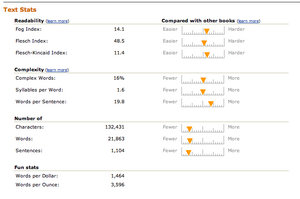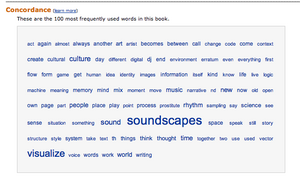New Amazon Features: Translating the Bookstore Experience On-line
Amazon is offering new Text Stats on “Readability” and “Complexity”, and a Concordance feature, both part of their comprehensive effort to translate the physical book[store] experience into the online medium. The new features build on existing capabilities such as Look Inside, Wishlists, Recommendations, Editorial and Customer Reviews, Citations, and Better Together to create a comprehensive book buying experience. In the same way that bookstores include kiosks to allow customers access metadata and other information on the books for sale in the immediate environment, Amazon is offering on-line capabilities that simulate many of the activities of book buyers in a bookstore, such as checking the table of contents and indexes, flipping through a book to read passages, or look at select pages.
The new features appear on product pages for books, as well as other kinds of works. [Try this intro to FRBR for a look at the conceptual hierarchy differentiating works from items, and it’s implications for common user tasks like finding, identifying, selecting, and obtaining items.]
Text Stats may be experimental, but it’s hard to feel comfortable with their definition of complexity, which is: “A word is considered “complex” if it has three or more syllables.” To point out the obvious, English includes plenty of simple three syllable words – like “banana” – and some very complex one syllable words – “time” “thought” and “self” for example.
The Text Stats on Readability seem a bit better thought through. That’s natural, given their grounding in research done outside Amazon’s walls. But with clear evidence that US education standards vary considerably across states and even individual districts, and also evidence that those standards change over time, I have to question the value of Readability stats long term. I suppose that isn’t point…
The Concordance feature is easier to appreciate; perhaps it doesn’t attempt to interperet or provide meaning. It simply presents the raw statistical data on word frequencies, and allows you to do the interpretation. Amazon links each word in the concordance to a search results page listing the individual occurances of the word in the text, which is useful, and then further links the individual occruance listings to the location within the text.
With this strong and growing mix of features, Amazon both translates the bookstore experience on-line, and also augments that experience with capabilities available only in an information environment. The question is whether Amazon will continue to expand the capabilities it offers for book buying under the basic mental model of “being in a bookstore”, or if a new direction is ahead?
Here’s a screenshot of the Text Stats for DJ Spooky’s Rhythm Science.
Text Stats:

Here’s a screen shot of the Concordance feature.
Concordance:

Category: Modeling, User Experience (UX) | Tags: books, customer_experience, mental_models, servicedesign, userexperience Comment »